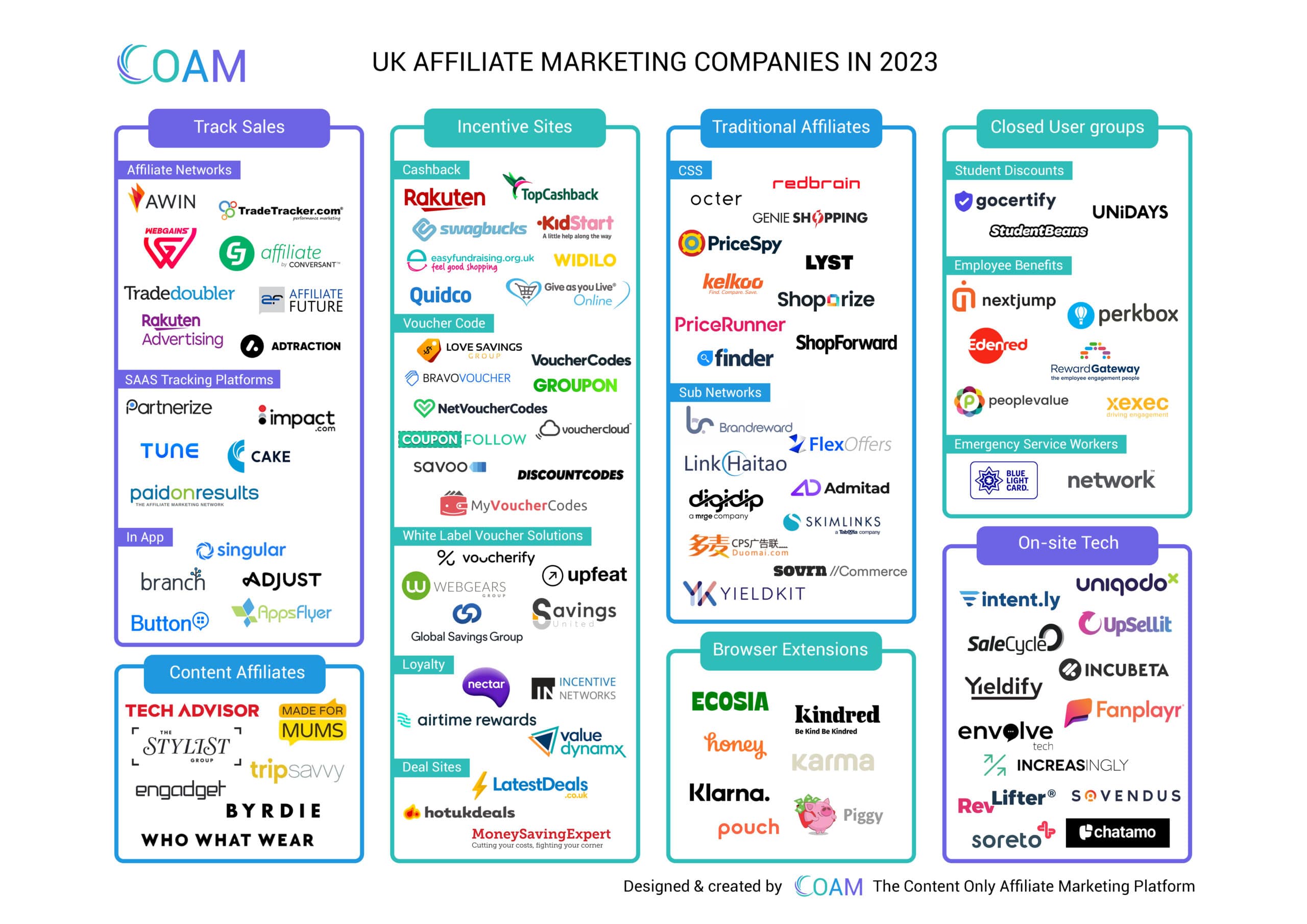
A Beginners Guide to The Affiliate Marketing Landscape
The affiliate marketing landscape in 2023 is challenging. Years can pass before a newcomer to the industry fully understands all of the major players and how they interact. The big changes that occur each and every year such as rebrands, acquisitions and new technologies make it a thriving, vibrant and complex ecosystem. It is harder than ever for individuals to educate themselves with an increasingly remote work-life and so using our industry experience, we wanted to help.
To ease the burden on anyone encountering the industry for the first time we have created a handy guide to affiliate marketing companies in the UK, which hopefully covers all of the major companies in our industry.
Table of Contents
Tracking Sales
Affiliate Networks
Affiliate networks offer the technology to track sales for any online shop whilst also opening the door for retailers to partner with lots of different businesses that can deliver them traffic or sales. Other functions of affiliate networks include:
- Partner outreach & recruitment: Identifying new businesses that could promote a retailer’s shop/service
- Partner engagement & campaign management: Utilising opportunities with existing affiliates to increase sales
- Reporting & analysis: Monitoring the impact of campaigns and new affiliates whilst adding insights from the industry at large.
- Compliance: Ensuring that the affiliates on a retailer’s program drive sales legitimately
In recent years we have seen the decoupling of technology (the tracking and platform used to access information about how well the program is doing) and service (the optimisation, recruitment, campaign analysis and compliance). This, in part, has happened because retailers have started to use SaaS (software as a service) companies for the technology part alongside their own internal staff to handle the service requirements. Most recently, affiliate networks have reacted to this by offering different service levels and pricing points to allow retailers to choose the technology and service mix best suited to their business.
Saas Tracking Platforms:
The role of a Saas tracking platform from a technology perspective is almost identical to that of an affiliate network. They track sales and open the door for retailers to partner with a wide range of different businesses. Perhaps the biggest USP (aside from price point) is that most of them facilitate one access point and unified reporting/invoicing for global retailers that want affiliate programs in different territories. Saas tracking platforms are most commonly used by affiliate agencies (for price point) and global retailers (for ease of setup)..
In App:
Tracking inside apps is more complicated than tracking on the web and as a result we have seen the creation of companies who focus on tracking affiliate sales where the customer has purchased inside a retailer’s app. These solutions sometimes plug into existing affiliate networks or Saas tracking platforms so you can see the full contribution of an affiliate in one place. More commonly though, these are stand alone solutions which can be applied to all marketing channels to help understand how in-app sales are referred.
Content Sites in the Affiliate Marketing Landscape
The bread and butter of the affiliate industry, content sites write about products or services, usually focusing on just one specific niche or area of expertise. They embedding affiliate links to retailer websites where appropriate and have been around since the industry’s inception in the early 2000’s. Their traffic is usually good at introducing users to a new brand or service as they hold the trust of their readership.
Incentive Sites of 2023
Cashback:
Cashback sites use the commission they receive from retailers to fund a cash reward they give to the purchasing customer. It’s a fairly simple concept and it’s no surprise to learn that cashback sites make up almost 30% of the revenue delivered by the vast majority of affiliate programs.
Loyalty:
Loyalty sites operate in a similar way to Cashback in that they use the commission they receive for referring a customer to a retailer to fund a reward. These rewards take the form incentives such as Avios, Nectar points or in-game rewards etc…. Money Saving Expert has more detail on how cashback and loyalty sites work.
Voucher Code:
Voucher code sites do exactly what the name suggests and offer users voucher codes to help them save money on their shopping. These types of businesses frequently take ‘offers’ promoted on a retailer’s own website in order to have more content on their site and increase their rankings on Google whilst also alerting users to the best price led products. A recent check on https://ahrefs.com (a tool that tells you what keywords websites get their traffic from on Google) reveals that all major voucher sites get at least 70% of their search engine traffic from “brand + voucher” or “brand + discount” related terms.
Deal Sites:
Deal sites do are self explanatory in that they highlight price led deals to consumers. Where they differ from voucher code sites is that most of their traffic comes directly to their site (essentially the starting point for a lot of consumer journeys). They also rely on offers that are product based, not store based and as a result they tend to restrict promotions on-site to those that are “best in market”, often with a community of users who verify how good each one is.
White Label Voucher Solutions:
White label voucher solutions are companies that collect content from all the retailers they work with and use it to create a “plug and play” voucher site that can be set up on any website. Typically, these solutions are sold to newspaper sites (like the Daily Mail) or publication houses (like Marie Claire). These sites are well thought of by Google due to their thousands of pages of unique content and well-known domain names. As a result, the voucher pages rank well and get lots of traffic (and therefore deliver lots of sales to retailers).
Cashback & Loyalty sites combine with Voucher sites (and their white label counterparts) to be the highest revenue generating sites in affiliate marketing. An affiliate program will typically have around 60-80% of their revenue driven by these types of sites.
Traditional Affiliates
CSS (Comparison Shopping Services):
CSS affiliates buy traffic from Google based on product related keywords the user has typed in. They have a special arrangement with Google which means they complement rather than compete with a retailer’s own shopping based search activity. When a CSS affiliate buys traffic, it serves the user an ad like the ones below and you can see the name of the CSS company at the bottom of each unit (or you’ll see “By Google” when the retailer themselves has bought the ad):

Google themselves have a very useful article on how CSS works alongside some of the common FAQs if you’d like to learn more. It’s worth noting that CSS ads are very prominent in the retail sector but less so in other verticals.
Sub Networks:
Sub Networks are used by affiliates to reduce the admin involved in joining multiple affiliate networks and creating affiliate links. They do this by converting direct links on an affiliate’s site into trackable monetised links (from SaaS providers or affiliate networks. There are two consequences to this:
- They lower the barrier to entry for lots of affiliate businesses and allows them to make money without affecting their editorial independence, creating an almost “passive” income for them. This is especially important to publication houses who use these services a lot.
- They monetise links that were previously linking directly to retailers (for free) and prevent any positive SEO impact the retailer may have gained through their own PR outreach.
There is also a real mix of quality and diversity of affiliates that use these services. In the last few years, sub networks have begun splitting out their voucher sites and content sites so that it’s clearer where their traffic comes from. Many retailers use this clarity to create varied rules/payouts for different affiliate types.
Closed User Groups in the Affiliate Industry 2023
Student Discounts
Student Discount websites offer discount codes specifically to students. They ensure that their offers only reach an audience of students by having their links and codes hidden behind a login. This login can only be accessed once the user has proven that they have a university based (or similar) email address.
Alongside their own student discount websites, the companies that operate in this field often encourage retailers to advertise their student discount on their own site and provide them with a means of hosting (and verifying) the offer without needing to go back to the student discount site. This is called “on-site verification” and all the companies in this space offer it. On-site verification is a good way of engaging a student audience although it does also risk losing margin by driving customers already on your website to the student discount.
Employee Benefits:
Employee Benefit solutions offer discounts specifically to employees of particular companies. The entities who create employee benefit portals sell their services to employers of all sizes varying from employees of McDonalds through to employees of 4-10 person small businesses. Each solution provider will have information on how many employers they work with, the total number of employees they can reach and their typical demographic.
Employee Benefit platforms ensure their offers and codes are not leaked by only allowing their codes and links to be accessed from within an employer’s intranet (internal internet) system.
Emergency Service Workers:
Similar to Student Discounts, Emergency Service Worker discounts offer voucher codes to those who work in public emergency services such as Police, Health Care, Fire people, Military, Teachers and other such heroes. It’s a way for retailers to give back to the people that provide essential life services.
As is the case with Student Discount services, the service providers here verify the employment of their users through email addresses and their links /offers are hidden behind logins.
Tech Solutions
Browser Extensions (& Toolbars)
Browser Extensions & Toolbars are pieces of software downloaded by users and perform various functions/roles that make it convenient for users to earn rewards (such as points or cashback) or find discounts as they shop. There are a mix of behaviours across this broad spectrum of affiliates but the core capabilities can include:
– Changing the user’s default search engine to a reskinned version of Google’s search results that has affiliate links instead of direct links to retailers.
– Changing the user’s search experience to add a logo or reminder to earn rewards when displaying search results of potential retailers.
– Serve alerts on the websites of retailer’s pages prompting them to earn rewards from the retailer they are about to buy from.
– Providing (and trying) discount codes for users on a retailer’s basket page.
These solutions are often popular with users for their ease of use and convenience but divide opinion among retailers given they engage with consumers when they are already on a retailer’s website and sometimes already in the checkout process.
On-Site Tech:
On-Site technology solutions offer retailers a wide variety of marketing functionality that helps them take back control of how their website interacts with customers. This could include:
– Serving information or offer ‘overlays’ based on criteria set by the retailer (such as attempting to leave the site or being at the checkout but with a low basket value).
– Creating a voucher code listings page on the retailer’s own site with personalised offers based on the user’s previous search and purchase activity
– Providing an Amazon style widget that shows complementary products to what the user has in their basket or is currently viewing.
– Post purchase promotion services. These come in two formats; an incentive for customers who have just purchased to spread the word about this retailer or an incentive for this customer from another complementary service/retailer.
All of these services require a retailer to put technology on their own site that they do not control and there are risks associated with this. These companies also work to a mix of models, some are happy on CPA, others require a licence fee and there is an ongoing debate about whether these companies should be called “affiliates”.
Roundup of the Affiliate Marketing Landscape in 2023
The affiliate marketing landscape is a beautifully complex and diverse ecosystem with lots of companies that a retailer can use to deliver sales and revenue to their online shop. Understanding the existence and capabilities of the different affiliate types referenced above will ensure that you extract as much value as possible out of your affiliate program and we hope you enjoyed our overview!


Add a Comment